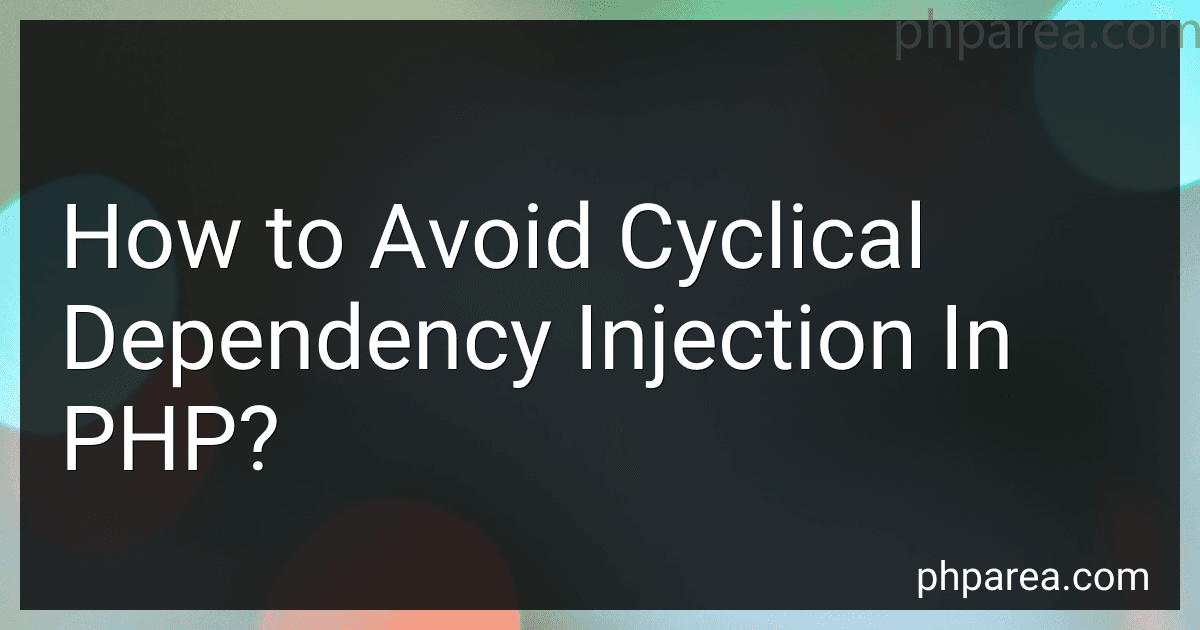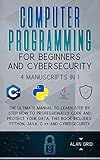Best PHP Dependency Injection Solutions to Buy in December 2025
Cyclical dependency injection refers to a situation where two or more classes depend on each other, leading to a circular reference. In PHP, this can cause issues as it can result in an endless loop or cause the application to crash. To avoid cyclical dependency injection, consider the following approaches:
- Review and refactor your code: Analyze the dependencies between your classes and identify any circular references. Consider whether these dependencies are necessary or can be eliminated. Refactor the code to remove or reorganize the dependencies.
- Use constructor injection: Instead of injecting dependencies through setters or methods, use constructor injection. This ensures that all required dependencies are provided when an object is instantiated, minimizing the chances of circular references.
- Implement setter injection carefully: If you need to use setter injection, make sure you handle it properly. Avoid setting dependencies that result in circular references and make sure all dependencies are injected before they are used.
- Implement lazy loading: If you have classes with circular dependencies, you can employ lazy loading techniques. This means that dependencies are only loaded when they are needed, rather than being loaded upfront. This can help break the circular reference chain and prevent cyclical dependency injection issues.
- Consider using a dependency injection container: A dependency injection container, also known as a DI container or an inversion of control (IoC) container, can manage your dependencies and prevent cyclical injection. These containers often provide built-in mechanisms to handle circular references and ensure proper injection order.
Remember, cyclical dependencies should be avoided whenever possible, as they can make your code difficult to maintain, understand, and test. It is essential to design your classes and dependencies in a way that promotes loose coupling and avoids circular references.
What are circular references in PHP?
In PHP, circular references occur when there is a mutual dependency between two or more objects or variables. This means that an object (or variable) references another object, which in turn references the first object, forming a loop.
Circular references can cause memory leaks because PHP's garbage collector cannot always detect and clean up these references automatically. This can result in memory consumption increasing continuously or remaining allocated for objects that are no longer needed.
To handle circular references in PHP, developers can use various techniques such as implementing weak references, manually removing the references when they are no longer needed, or breaking the circular reference by reorganizing the code structure.
What is dependency injection in PHP?
Dependency injection in PHP is a design pattern that allows the code to be more modular, flexible, and testable. It is used to manage the dependency between classes by injecting the required dependencies into a class rather than the class creating the dependencies itself.
In simple terms, in dependency injection, instead of a class creating the objects it depends on, those objects are provided or "injected" into the class from an external source. This external source is typically called a "container" or "injector".
This approach helps in decoupling the classes, making it easier to change or substitute dependencies without affecting the class itself. It also enables better unit testing as dependencies can be easily mocked or replaced.
There are several ways to implement dependency injection in PHP, such as constructor injection, setter injection, and interface injection. Constructor injection is the most common and recommended method, where the dependencies are passed as parameters to the class constructor.
By using dependency injection, PHP developers can write more modular and maintainable code that is easier to test and refactor.
How to avoid property injection in PHP?
To avoid property injection in PHP, you can follow the following best practices:
- Use Dependency Injection (DI) container: Utilize a DI container like Symfony's DependencyInjection component or Laravel's IoC container. These containers manage the creation and injection of dependencies, allowing you to define dependencies in a central configuration file.
- Implement Constructor Injection: Instead of directly assigning properties within a class, pass the dependencies via the constructor. This ensures that all required dependencies are explicitly defined and not susceptible to injection.
- Use Interfaces and Type Hinting: Declare dependencies using interfaces instead of concrete implementations. This improves flexibility and allows for easier testing and swapping of dependencies without modifying the code extensively. Always use type hinting to enforce the correct type of dependencies.
- Avoid using the global scope: Avoid the use of global variables as they can be easily manipulated from outside sources. Instead, encapsulate data within a class and use proper access modifiers (e.g., private, protected) to control access to properties.
- Implement Access Control: Use access modifiers (private, protected, public) to restrict access to properties and methods. By default, properties should be set as private to prevent external manipulation.
- Validate and Sanitize Input: Ensure that any user input or data received from external sources is properly validated and sanitized before using it as property values. This helps prevent injection attacks.
- Implement OWASP's guidelines: Following the Open Web Application Security Project (OWASP) guidelines for PHP can help you secure your application against various vulnerabilities, including property injection.
- Keep software up to date: Stay updated with the latest PHP versions and security patches as they often include security enhancements and bug fixes that mitigate various vulnerabilities.
By adhering to these best practices, you can significantly reduce the risk of property injection in your PHP code.
How does the single responsibility principle relate to dependency injection in PHP?
The Single Responsibility Principle (SRP) states that a class should have only one reason to change, meaning it should have a single responsibility or job to do. This principle encourages developers to keep their classes focused, maintainable, and loosely coupled.
Dependency Injection (DI) is a technique used to implement the principle of Inversion of Control (IoC) where the dependencies of a class are not directly created by that class, but are passed from the outside. In PHP, DI is commonly implemented using constructors or setter methods to inject dependencies.
So, how does SRP relate to DI in PHP?
- Separation of Concerns: By adhering to the SRP, classes become more focused and have a specific responsibility. This makes it easier to identify and extract the dependencies required for that responsibility.
- Loose Coupling: When a class has only one responsibility, it becomes more independent and less tightly coupled with other classes. This enables easier DI, as the class doesn't depend on specific implementations, but rather on interfaces or abstractions. It allows for better flexibility and maintainability when injecting different implementations as dependencies.
- Testability: Following the SRP helps improve the testability of classes. When a class is focused on a single responsibility, it becomes easier to write unit tests for that specific aspect. With DI, dependencies can be easily mocked or stubbed in tests to isolate the class under test.
In summary, SRP encourages the development of focused and maintainable classes. DI complements this principle by enabling loose coupling and the ability to easily switch dependencies. By combining SRP and DI in PHP, you can write more modular, testable, and flexible code.
How to avoid cyclical dependency injection in PHP?
To avoid cyclical dependency injection in PHP, you can follow these strategies:
- Use constructor injection: Instead of injecting dependencies through setter methods, dependencies should be injected via constructor parameters. This ensures that all necessary dependencies are resolved before an object is instantiated and eliminates the possibility of cyclical dependencies.
- Apply dependency inversion principle (DIP): DIP suggests that high-level modules should not depend on low-level modules; both should depend on abstractions. By creating and injecting abstractions (interfaces or abstract classes) instead of concrete implementations, you can break the cyclical dependency chain.
- Use lazy loading: Rather than resolving all dependencies at once, you can use lazy loading or lazy initialization to instantiate dependencies only when they are actually needed. This can help break the dependency cycle and ensure that dependencies are not resolved prematurely.
- Refactor and simplify your code: Analyze your codebase to identify any unnecessary and excessive dependencies. Consider refactoring your code to reduce the number of dependencies or break down complex classes into smaller, more manageable ones. This can help to eliminate cyclical dependencies and improve the overall design.
- Apply design patterns: Various design patterns, such as the Factory pattern or the Dependency Injection Container pattern, can be used to manage and resolve dependencies effectively. These patterns provide structures and guidelines to handle dependency injection in a more organized and controlled manner, reducing the chances of cyclical dependencies.
Remember, careful planning and consideration of dependencies during the design phase can help you prevent cyclical dependency injection issues.



